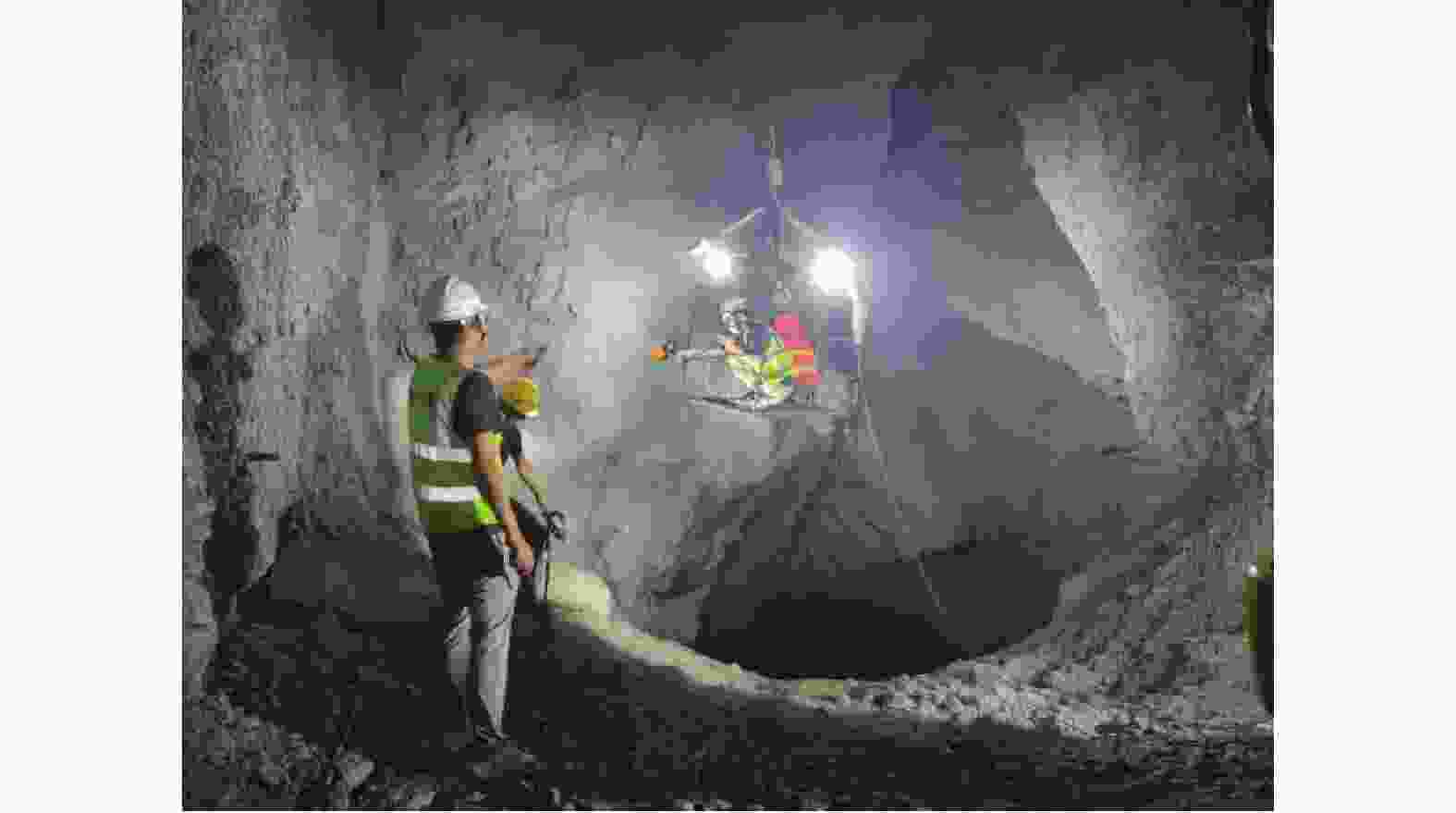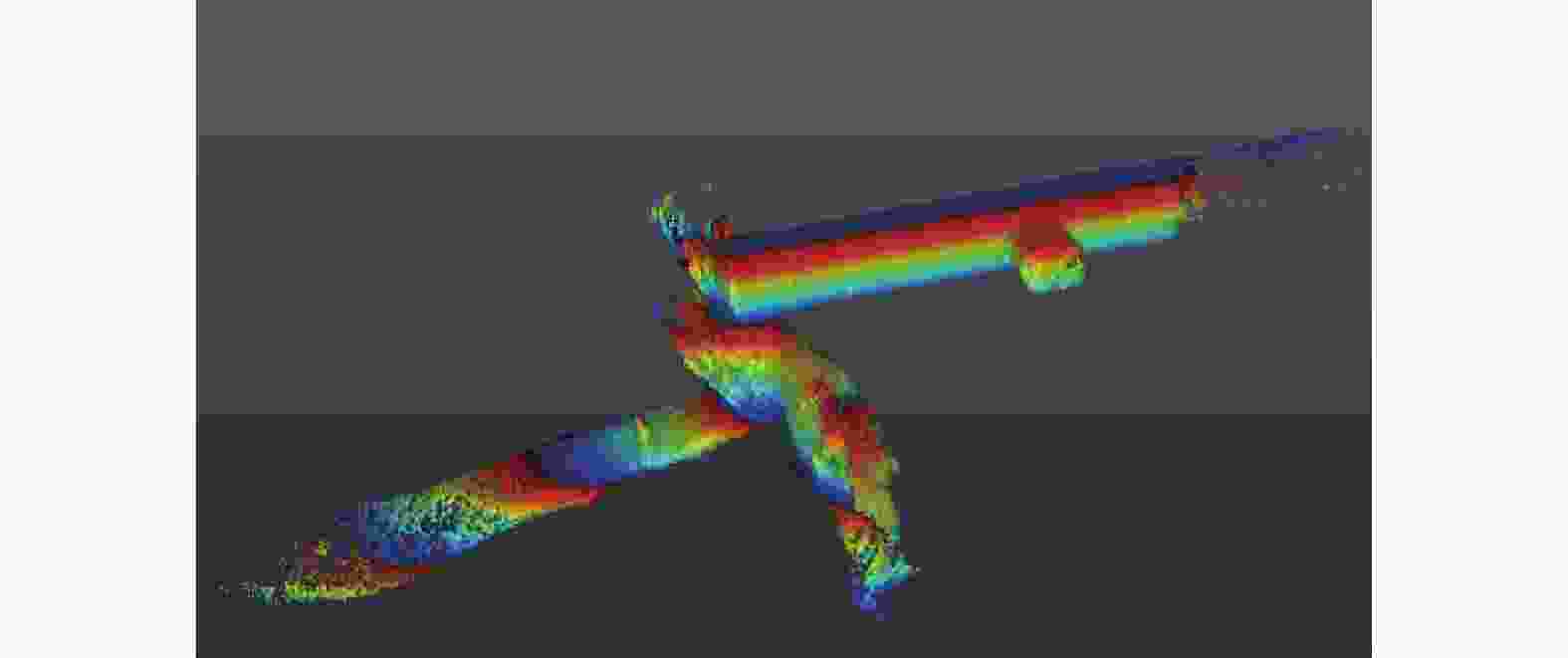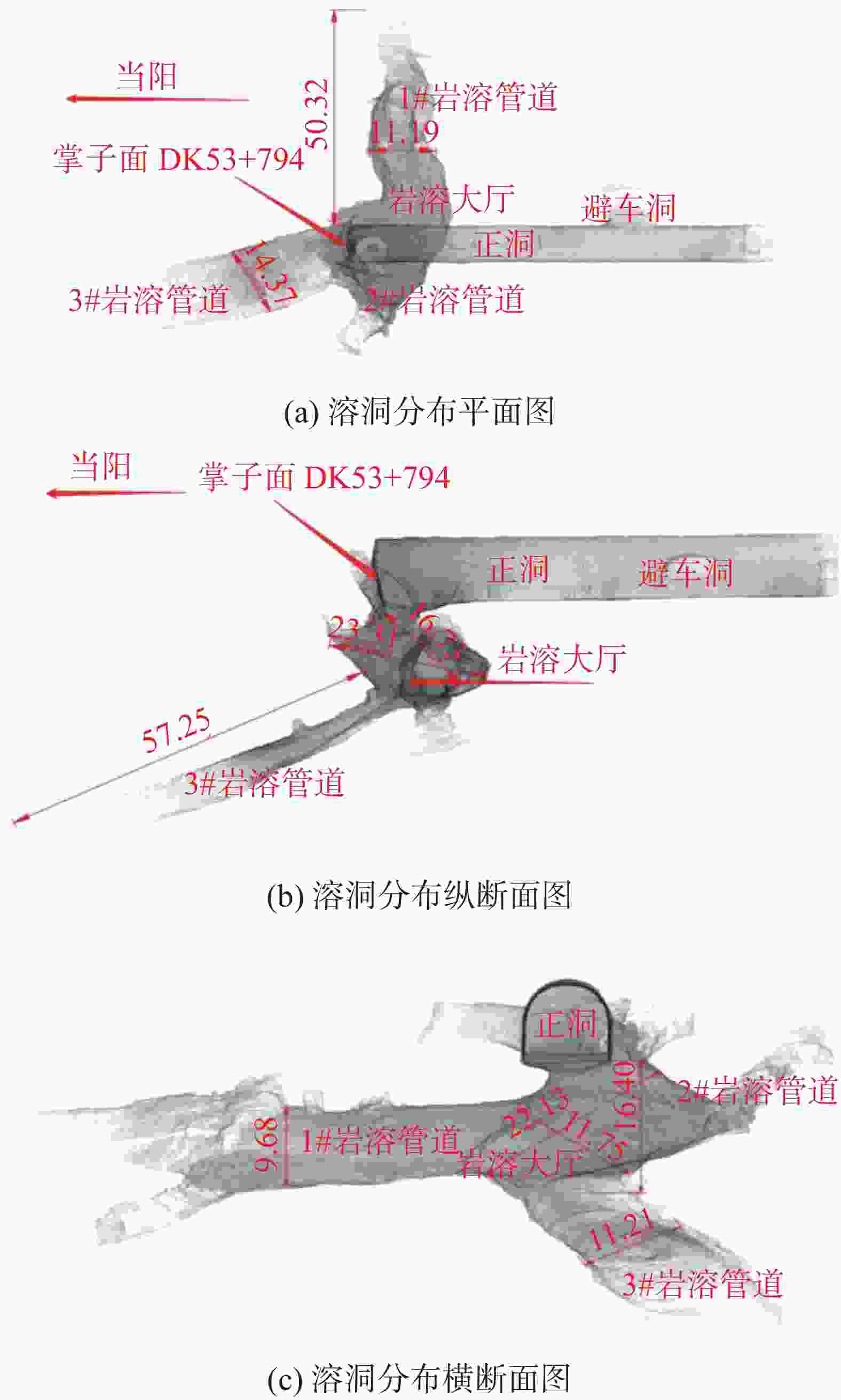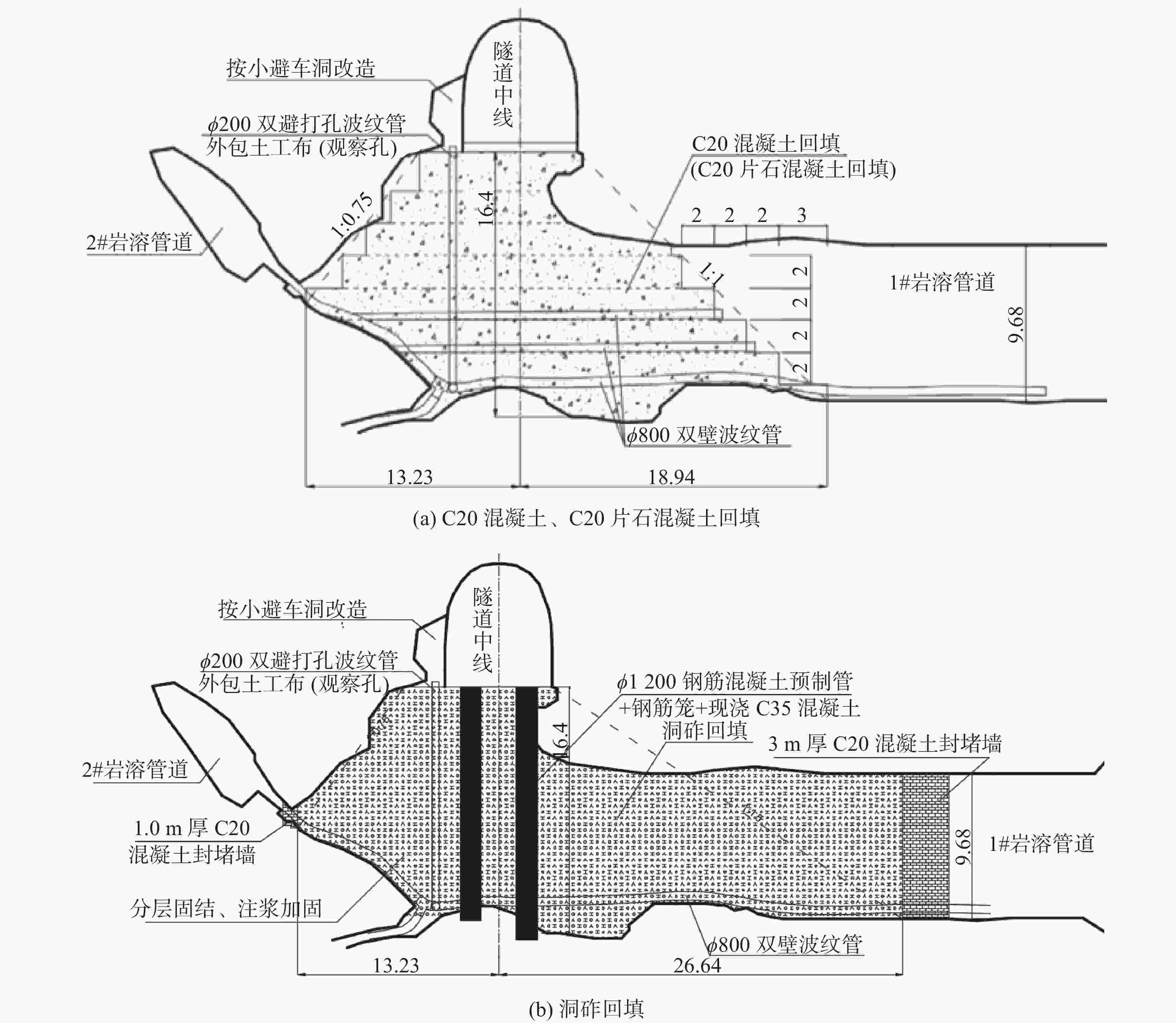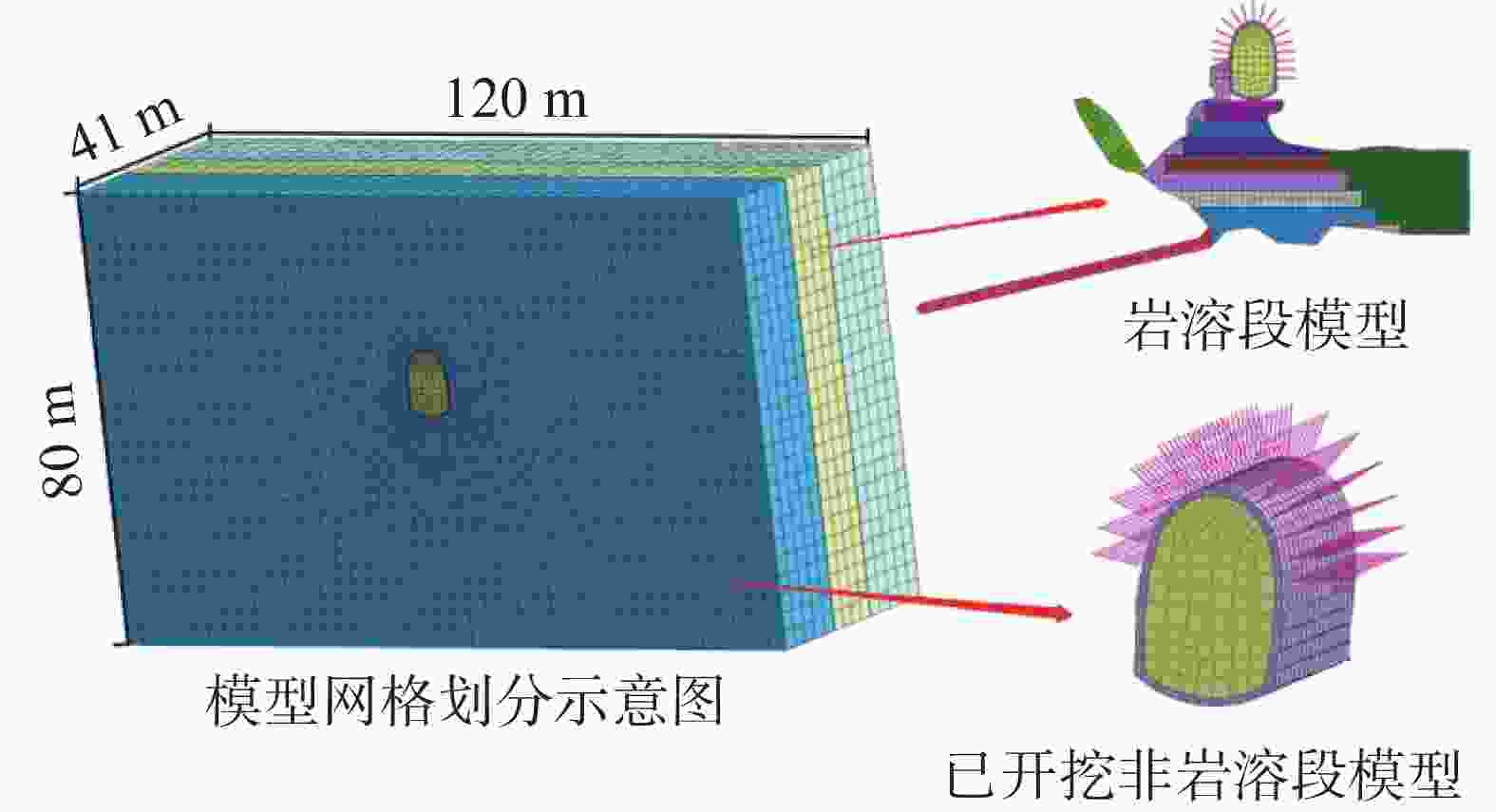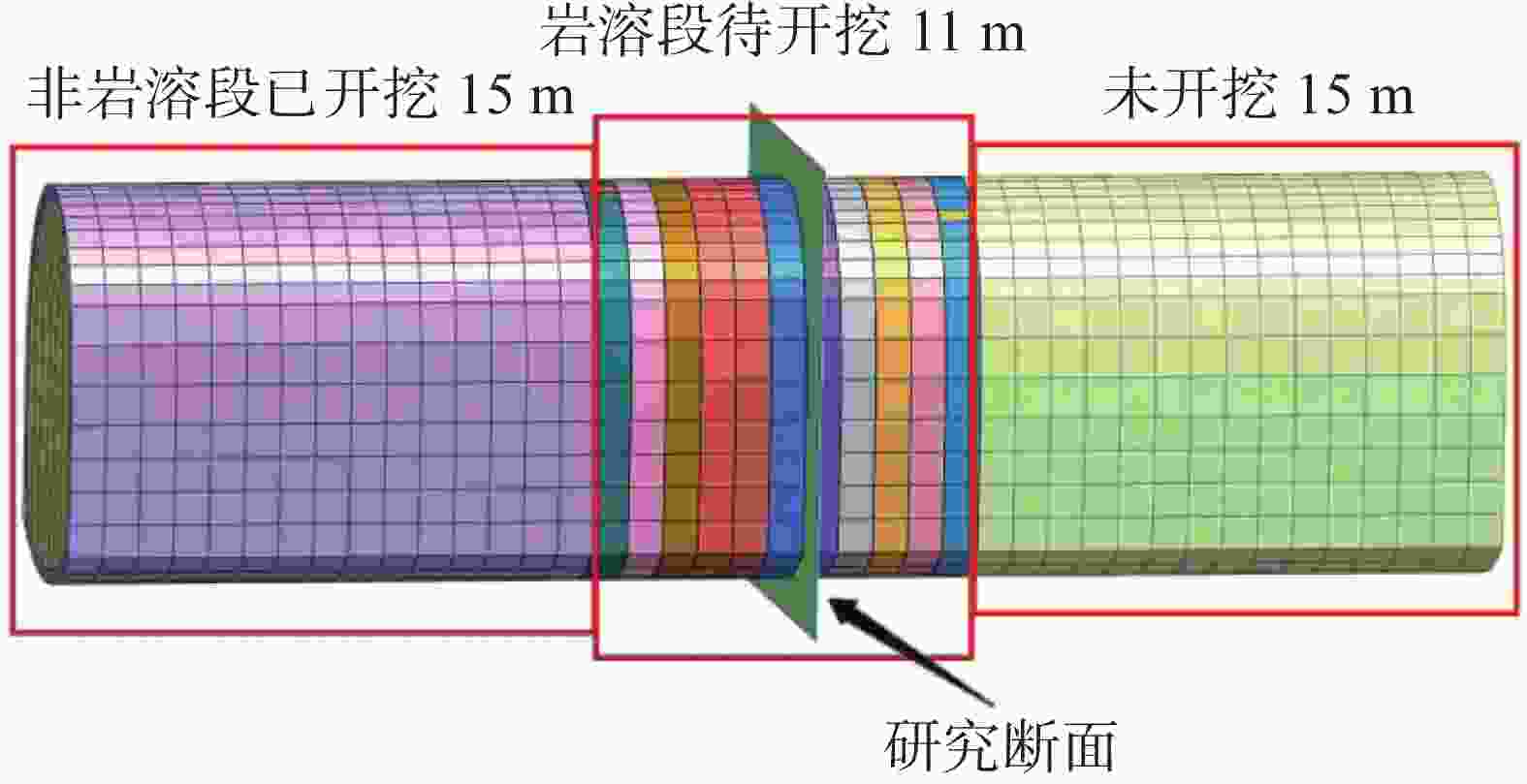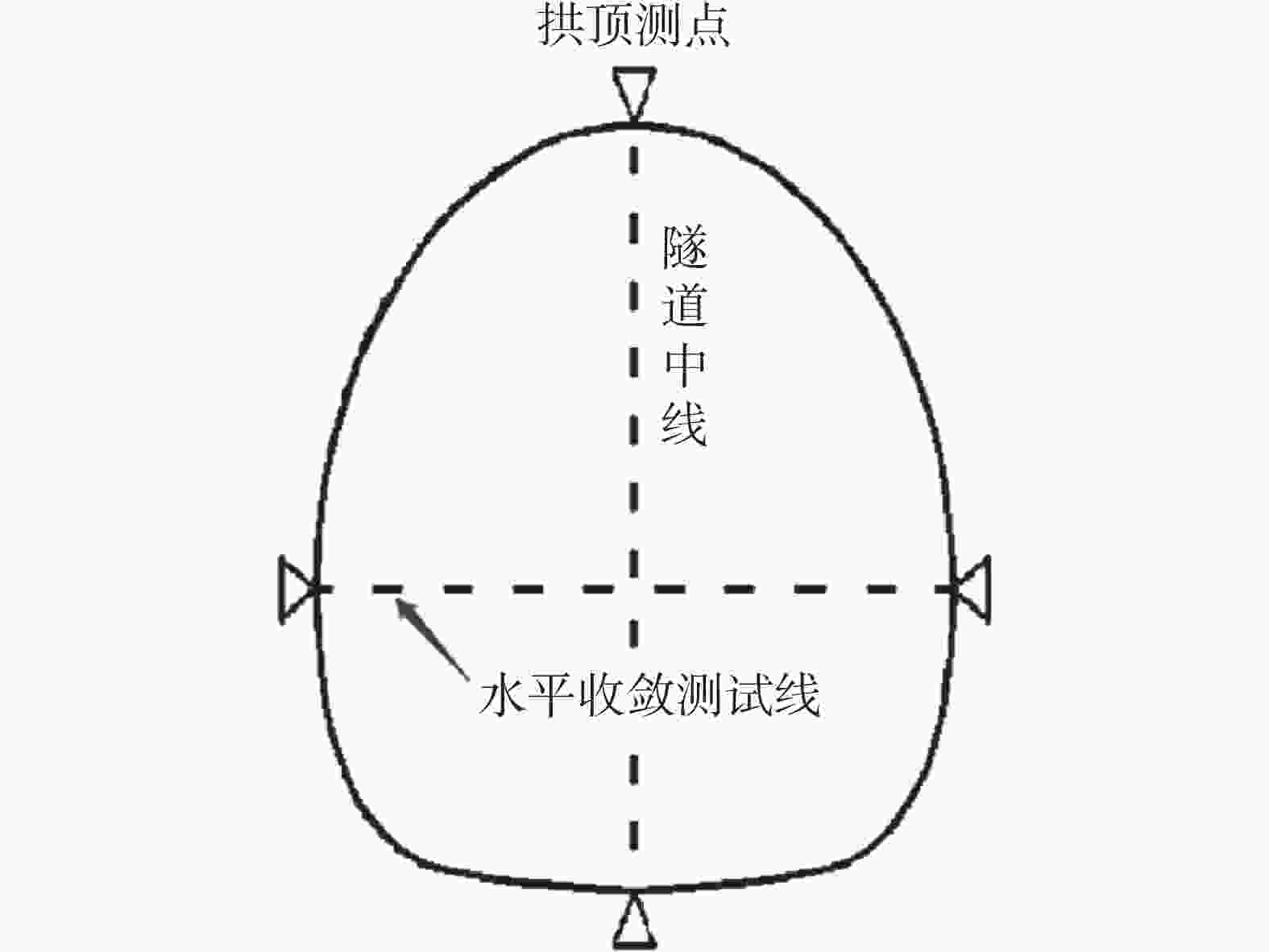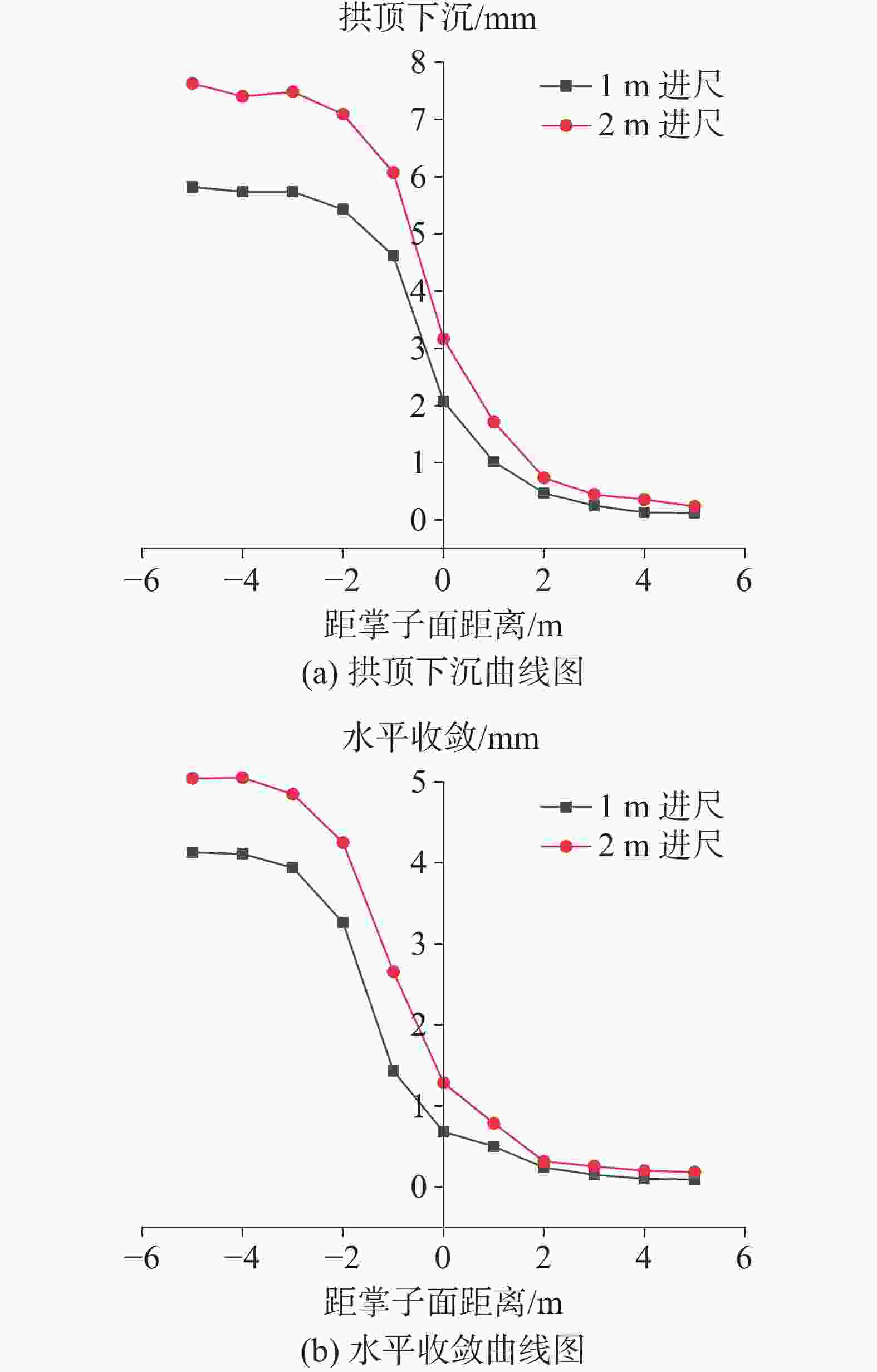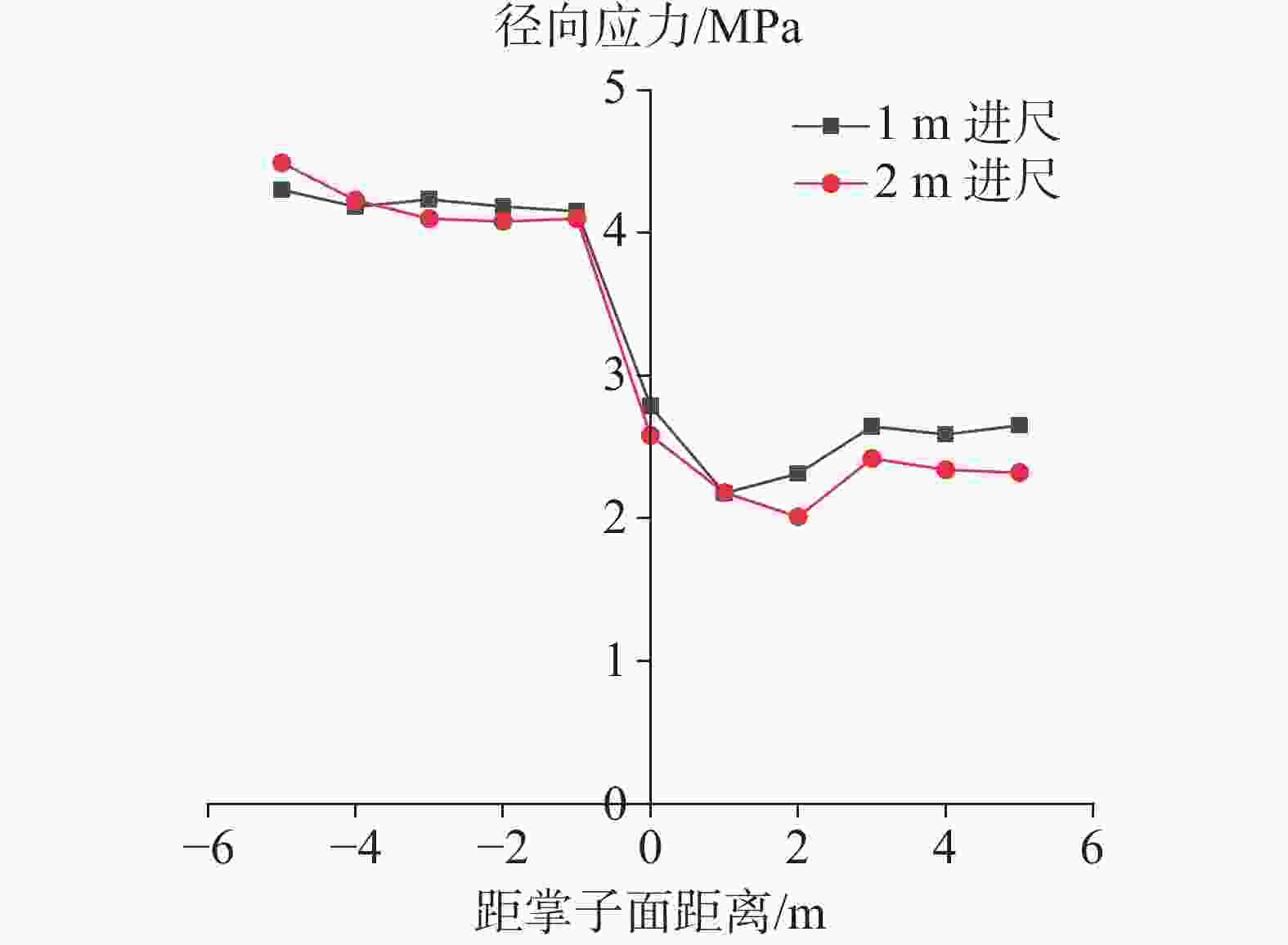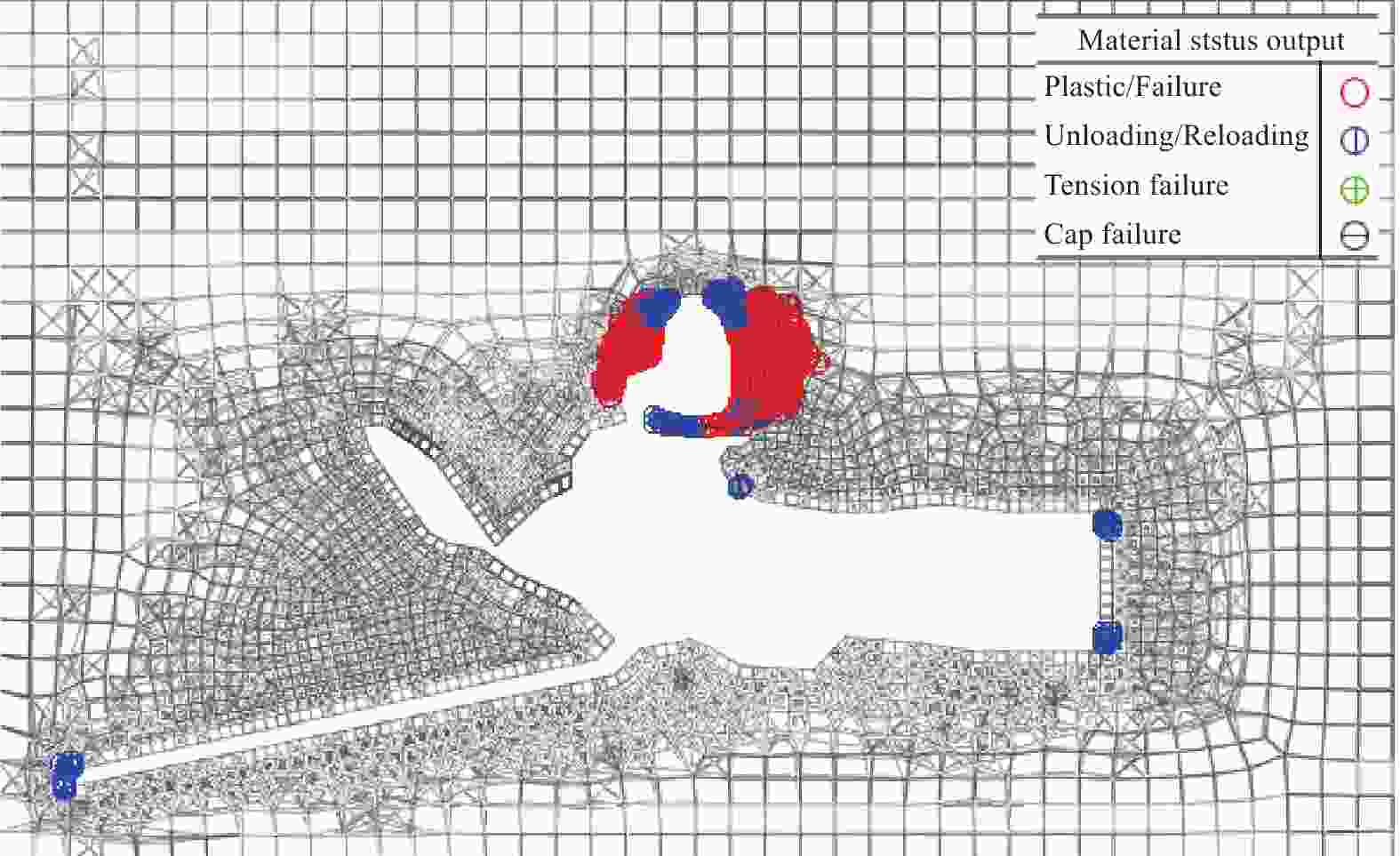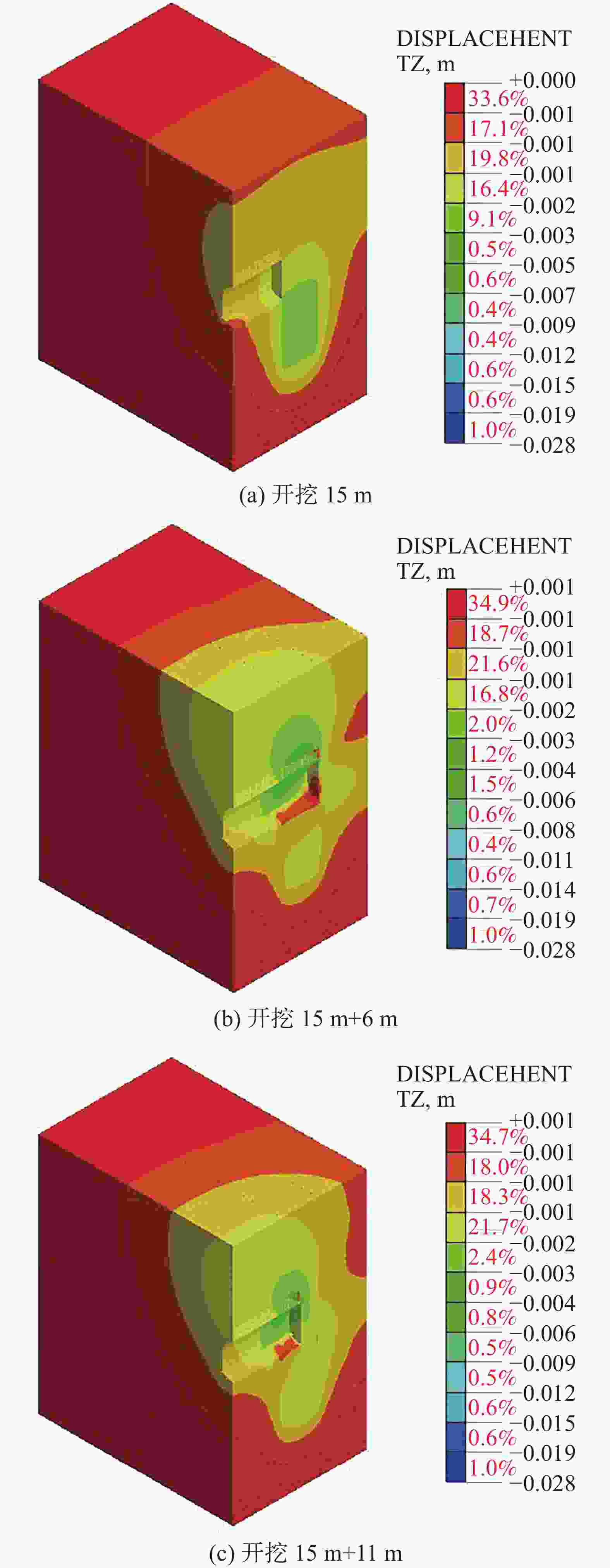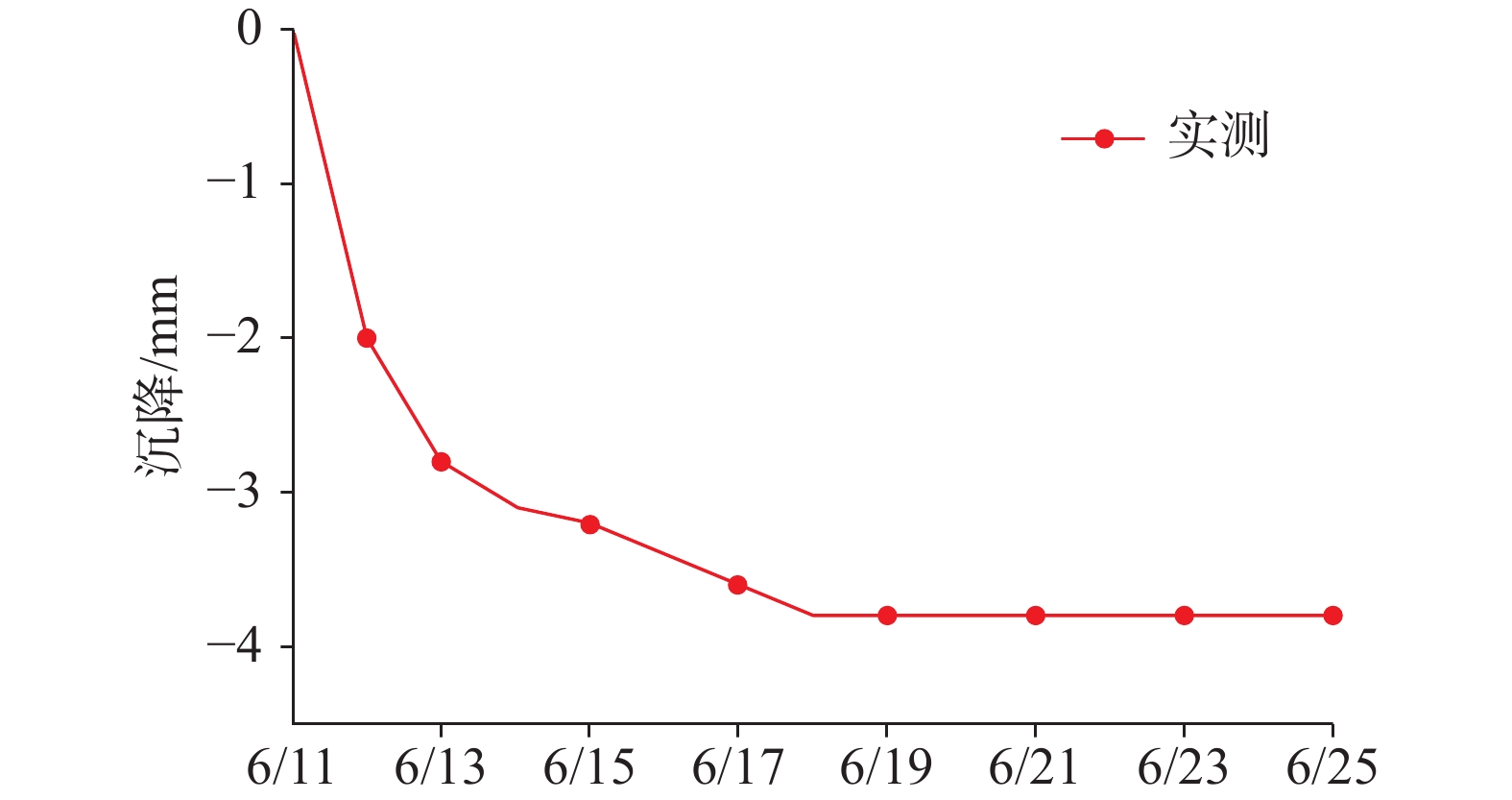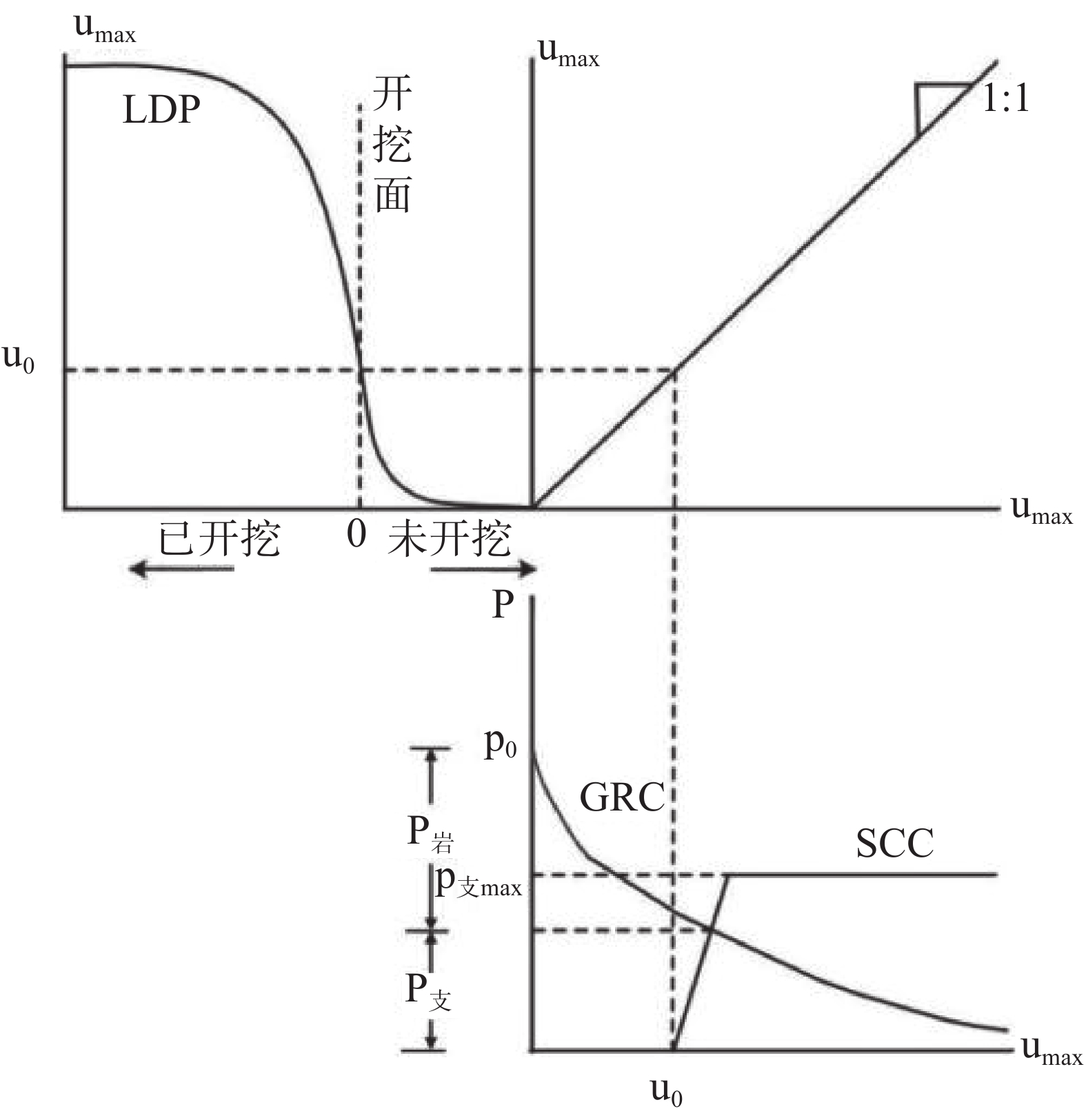Stability analysis of karst tunnel surrounding rock considering spatiotemporal effects
-
摘要: 采用全息三维激光扫描仪精确探查溶洞并获取三维点云数据,快速获取溶洞的几何特征和空间分布等基础数据,基于溶洞分布特征与隧道相对位置提出4种隧道岩溶处置措施。综合考虑施工工艺与工程经济效益,采用C20混凝土回填方案进行溶洞处治。利用MIDAS/GTS-NX对毛家坡隧道岩溶段的溶洞处治及处治后隧道的开挖–支护进行数值模拟,以高精度三维激光扫描探测到的溶洞形态、位置及大小为基础建立空溶洞模型,溶洞处治完成后进行隧道开挖–支护模拟。通过收敛–约束法获取岩溶隧洞开挖推进过程中围岩的纵向变形规律,对岩溶段隧道开挖前后的围岩应力与破坏特征进行研究,分析岩溶段与非岩溶段的围岩支护稳定性。研究结果表明:对比隧道非岩溶段和岩溶段的拱顶沉降与周边收敛,处治后岩溶段的拱顶沉降与水平周边收敛减小,岩溶段的处理措施合理。对比岩溶隧道不同进尺下的围岩纵向变形,开挖进尺与支护结构力负相关。选择合理的开挖进尺,既能保证围岩变形满足规范要求,又能使得支护刚度得到合理运用。Abstract:
During tunnel construction, various geological problems may be encountered, and karst development can cause great harm to the tunnel. Because the lithology of the rock mass in the karst area is poor and its structure is relatively broken, it is likely to occur the deformation of surrounding rock and even the instability and damage for the whole tunnel during the tunnel excavation. Due to the limitation of exploration technology and exploration cycle, as well as the irregularity of karst development itself, it is difficult to determine the karst morphology and properties. Therefore, it is very important for us to accurately detect the geometric characteristics of karst so as to propose a reasonable scheme of karst disposal and tunnel excavation, which can ensure the stability and construction safety of the surrounding rock in karst tunnel excavation. The deformation of the surrounding rock of tunnel follows the evolution law of "accelerated deformation–rapid deformation–slow deformation–stable deformation". The longitudinal deformation curve of the convergence–constraint method reveals the spatial effect of deformation of surrounding rock during tunnel excavation, and provides a theoretical basis for us to determine the best time for tunnel excavation support by analyzing the interaction between the surrounding rock and the supporting structure. In Maojiapo tunnel, a single-line single-hole railway tunnel from Dangyang to Yuan'an, a large karst cave is situated at the position of the bottom plate on the right side of the tunnel face. To ensure a clear understanding of the location and size of the cave, and the directions of cave branches, a holographic 3D laser scanner was used to obtain the 3D point cloud data on accurate survey of the karst cave, such as the basic data of geometric characteristics and spatial distribution of the karst cave. In this large and dry karst cave, there are long extended pipelines impacting little on the overall stability of the tunnel. In addition, the karst hall is located under the tunnel. Based on the distribution characteristics of the karst cave and the relative position of the tunnel, this study adopted different reinforcement schemes for the karst hall, and proposed four tunnel karst treatment measures, namely, bridge span, backfill with C20 concrete, backfill with C20 rubble concrete, and ballast backfill. After the four schemes were compared in terms of construction technology and economic benefits, the scheme of backfill with C20 concrete was adopted for karst cave treatment. MIDAS/GTS-NX was used to numerically simulate and analyze the excavation and support of the karst section of Maojiapo tunnel after the karst cave treatment had been completed. An empty-cave model was established based on shape, location and size of the karst cave detected by high-precision 3D laser scanning. The longitudinal deformation law of the surrounding rock during the karst tunnel excavation was obtained by the convergence–constraint method, and the stress and failure characteristics of surrounding rock before and after the tunnel excavation of the karst section were studied. The supporting stability of surrounding rock in the karst section and the non-karst section was analyzed. The results show that compared with the vault subsidence and peripheral convergence of the non-karst section and the karst section of the tunnel, the occurrences of vault subsidence and horizontal peripheral convergence of the karst section reduced after treatment, which indicated the treatment measures of the karst section were reasonable and feasible. Compared with the longitudinal deformation of surrounding rock at different footage of karst tunnel excavation, the footage is negatively correlated with the force of supporting structure. Choosing optimal excavation footage can not only ensure that the deformation of surrounding rock meets the requirements of the specification, but can also contribute to the reasonable use of supporting. This study makes a more complete evaluation of the treatment effect of karst caves and the basis of karst tunnel excavation. -
Key words:
- karst tunnel /
- spatiotemporal effect /
- 3D laser scanning /
- stability of surrounding rock
-
表 1 不同类型溶洞处理措施
Table 1. Treatment measures for different types of karst caves
项目(岩溶类型) 技术方案 洞穴型、管道型岩溶 回填 充填型岩溶 注浆加固+大管棚方案 过水型岩溶 引排方案 大型干溶洞 托梁+板跨护顶方案;
型钢混凝土+板跨方案;
钢管群桩方案;
护墙+桩基+承台方案;
路基填筑方案;
梁跨方案;
拱跨+护罩方案表 2 不同位置溶洞隧道加固方法
Table 2. Reinforcement methods for karst cave tunnels at different positions
溶洞位置 加固方法 位于隧道顶部 回填、护拱、喷锚网防护、
立柱支顶、拱罩防护位于隧道底部 回填、注浆、板(梁)跨越、
拱桥跨越、桩基承台位于隧道侧面 护墙防护以及支顶 表 3 回填方案对比
Table 3. Comparison of backfill schemes
序号 方案名称 可实施性
/d投资费用
/万元1 桥跨方案 \ \ 2 C20混凝土回填 10 约249 3 C20片石混凝土回填 24 约222 4 洞砟回填 35 约53 表 4 支护参数表
Table 4. Support parameters
类别 非岩溶断面 岩溶断面 围岩等级 Ⅲb Ⅴb C25喷射混凝土 厚度/cm 7 23 钢筋网 拱墙间距/cm 20×20 25×25 钢拱架 每榀间距/m \ 0.75 锚杆 (环×纵)间距/m 1.2×1.5 1.0×1.0 长度/m 2 3 二衬C30混凝土 厚度/cm 30 40 表 5 地层和隧道支护体的力学参数
Table 5. Mechanical parameters of strata and tunnel support
材料
类型弹性模量
E/GPa泊松比ν 容重
γ/KN·m−3粘聚力
c/MPa内摩擦
角Φ/°灰岩 1.5 0.4 20 0.08 23 初期支护 21 0.2 22 \ \ 二次衬砌 30 0.2 24 \ \ 锚杆 210 0.3 78 \ \ 表 6 不同进尺开挖掌子面变形数据
Table 6. Data on deformation of the tunnel face at different footage of excavation
隧道开挖进尺 拱顶沉降/mm 水平收敛/mm 1 m 进尺 5.82 4.13 2 m进尺 7.63 5.04 -
[1] 王文, 朱维申. 节理岩体隧道的稳定性分析[J]. 现代隧道技术, 2014, 51(6):66-72.WANG Wen, ZHU Weishen. Stability analysis of tunnels in jointed rock masses[J]. Modern Tunneling Technology, 2014, 51(6): 66-72. [2] 王亮, 郝海鹏, 郑向向, 吴昱芳, 江杰. 基于FAHP-TOPSIS的岩溶隧道超前地质预报方案优化[J]. 灾害学, 2023, 38(4):39-44.WANG Liang, HAO Haipeng, ZHENG Xiangxiang, WU Yufang, JIANG Jie. Scheme optimization of advanced geological prediction for karst tunnel based on FAHP-TOPSIS[J]. Journal of Catastrophology, 2023, 38(4): 39-44. [3] 孙海富. 高速铁路设计标准优化研究[J]. 铁道工程学报, 2020, 37(10):1-5.SUN Haifu. Research on the optimization of high speed railway design standards[J]. Journal of Railway Engineering Society, 2020, 37(10): 1-5. [4] 谢尊贤, 徐宝, 骆信慧, 李国良. 高原隧道施工安全风险控制方法研究与应用[J]. 地下空间与工程学报, 2023, 19(2):622-631.XIE Zunxian, XU Bao, LUO Xinhui, LI Guoliang. Research and application of safety risk control method in plateau tunnel construction[J]. Journal of Underground Space and Engineering 2023, 19(2): 622-631. [5] 曹武安. 溶洞对隧道围岩稳定性影响的数值分析[D]. 沈阳:东北大学, 2006.CAO Wu'an. Numerical analysis of influence of karst caves on stability of tunnels surrounding rock mass[D]. Shenyang: Northeastern University, 2006 [6] 李硕. 溶洞对盾构隧道围岩稳定性影响的数值模拟[D]. 大连:大连交通大学, 2019.LI Shuo. Numerical simulation of influence of karst cave on surrounding rock stability of shield tunnel[D]. Dalian: Dalian Jiaotong University, 2019 [7] 韦征, 周臻, 俞旻韬, 王永玮. 基于三维激光扫描点云整体分析的铁路隧道超欠挖检测方法[J]. 铁道学报, 2023, 45(1):135-140.WEI Zheng, ZHOU Zhen, YU Mintao, WANG Yongwei. Research on detection method for tunnel underbreak and overbreak based on 3D laser scanning point cloud integral analysis[J]. Journal of the China Railway Society, 2023, 45(1): 135-140. [8] 胡玉祥, 赵亚波, 张洪德, 韩磊, 孟庆年. 移动三维激光扫描系统在地下隧道工程病害检测中的应用[J]. 测绘与空间地理信息, 2022, 45(12):230-232, 235. doi: 10.3969/j.issn.1672-5867.2022.12.066HU Yuxiang, ZHAO Yabo, ZHANG Hongde, HAN Lei, MENG Qingnian. Application of mobile 3D laser scanning system in underground tunnel engineering disease detection[J]. Geomatics and Spatial Information Technology, 2022, 45(12): 230-232, 235. doi: 10.3969/j.issn.1672-5867.2022.12.066 [9] 唐东跃, 肖书安, 周兴华, 朱水鹏. 三维激光扫描技术在高铁隧道平整度检测中的应用[J]. 测绘通报, 2021, 534(9):160-164.TANG Dongyue, XIAO Shu'an, ZHOU Xinghua, ZHU Shuipeng. Application of 3D laser scanning technology in evenness analysis of high-speed railway tunnel[J]. Bulletin of Surveying and Mapping, 2021, 534(9): 160-164. [10] 张庆浩. 基于三维激光扫描的复杂溶洞三维建模与安全分析[D]. 厦门:厦门大学, 2017.ZHANG Qinghao. Three dimensional modeling and safety analysis of complex karst cave based on 3D laser scanning[D]. Xiamen: Xiamen University, 2017. [11] Feng Jimeng, Yan Congwen, Ye Lun, Ding Xiaoqi, Zhang Junru, Li Zili. Evaluation of installation timing of initial ground support for large-span tunnel in hard rock[J]. Tunnelling and Underground Space Technology, 2019, 93: 103087. doi: 10.1016/j.tust.2019.103087 [12] Xiang Yuzhou, Liu Hanlong, Zhang Wengang, Chu Jian, Zhou Dong, Xiao Yang. Application of transparent soil model test and DEM simulation in study of tunnel failure mechanism[J]. Tunnelling and Underground Space Technology, 2018, 74: 178-184. doi: 10.1016/j.tust.2018.01.020 [13] An Xuexu, Hu Zhiping, Su Yan, Cao Shuangli, Tao Lei, Zhang Yonghui. Initial support distance of a non-circular tunnel based on convergence constraint method and integral failure criteria of rock[J]. Journal of Central South University, 2022, 29(11): 3732-3744. [14] 张妍珺, 苏凯, 周利, 伍鹤皋. 基于收敛-约束法的隧洞纵向变形演化规律研究与支护时机估算[J]. 岩土力学, 2017, 38(Suppl.1):471-478.ZHANG Yanjun, SU Kai, ZHOU Li, WU Hegao. Estimation of ground support installation time based on the tunnel longitudinal displacement of convergence-confinement method[J]. Rock and Soil Mechanics, 2017, 38(Suppl.1): 471-478. [15] Yang Ling, Han Lijun, Wei Liyuan. Research on tunnel supporting time based on virtual supporting force[J]. Modern Tunnelling Technology, 2012, 49(1): 66-71. [16] 苏凯, 崔金鹏, 张智敏. 隧洞施工开挖过程初次支护时机选择方法[J]. 中南大学学报(自然科学版), 2015, 46(8):3075-3082.SU Kai, CUI Jinpeng, ZHANG Zhimin. Method of choosing initial supporting time during tunnel excavations[J]. Journal of Central South University (Science and Technology), 2015, 46(8): 3075-3082. [17] 梁裔举, 高山, 陈璐. 岩溶地区浅埋隧道变形分析及处治[J]. 交通科学与工程, 2023, 39(2):49-54.LIANG Yiju, GAO Shan, CHEN Lu. Research on deformation analysis and treatment technology of shallow buried tunnels in karst areas[J]. Journal of Transport Science and Engineering, 2023, 39(2): 49-54. [18] 张政. 岩溶溶洞对盾构隧道掘进安全性的影响特征与处理方法研究[D]. 济南:山东大学, 2021.ZHANG Zheng. Study on the influence characteristics and treatment methods of karst cave on the safety of shield tunneling[D]. Jinan: Shandong University, 2021. [19] 孟杰, 林志斌, 林培忠. 应力-渗流-损伤耦合作用下管道型岩溶隧道突水灾变规律研究[J]. 中国岩溶, 2023, 42(2):351-360.MENG Jie, LIN Zhibin, LIN Peizhong. Research on the law of water inrush disasters in pipeline-type karst tunnels under the coupling effect of stress-seepage-damage[J]. Carsologica Sinica, 2023, 42(2): 351-360. [20] 唐雄俊. 隧道收敛约束法的理论研究与应用[D]. 武汉:华中科技大学, 2009.TANG Xiongjun. Study on the convergence-confinement method and its application in tunnel construction[D]. Wuhan: Huazhong University of Science and Technology, 2009. [21] Zhao Dongping, Jia Lingli, Wang Mingnian, Wang Feng. Displacement prediction of tunnels based on a generalised Kelvin constitutive model and its application in a subsea tunnel[J]. Tunnelling and Underground Space Technology, 2016, 54: 29-36. [22] 周文龙, 高占冬, 吴克华, 黎有为, 李坡, 贺卫. 河北阜平神仙洞探测研究及开发建议[J]. 中国岩溶, 2020, 39(1):110-118.ZHOU Wenlong, GAO Zhandong, WU Kehua, LI Youwei, LI Po, HE Wei. Exploration and suggestions on development of the Shenxian cave in Fuping county, Hebei Province[J]. Carsologica Sinica, 2020, 39(1): 110-118. [23] 崔炫, 胡强. 深埋公路隧道溶洞处置效果分析与隧道结构响应规律研究[J]. 中国岩溶, 2022, 41(1):34-46.CUI Xuan, HU Qiang. Research on treatment effect of karst cave in deep-buried highway tunnel and response law of tunnel structure[J]. Carsologica Sinica, 2022, 41(1): 34-46. [24] 郭亚斌. 顺层偏压隧道变形特征及控制措施研究[D]. 兰州:兰州交通大学, 2020.GUO Yabin. Study on deformation characteristics and controlling measures of unsymmetrically loading tunnels in bedding strata[D]. Lanzhou: Lanzhou Jiaotong University, 2020. -




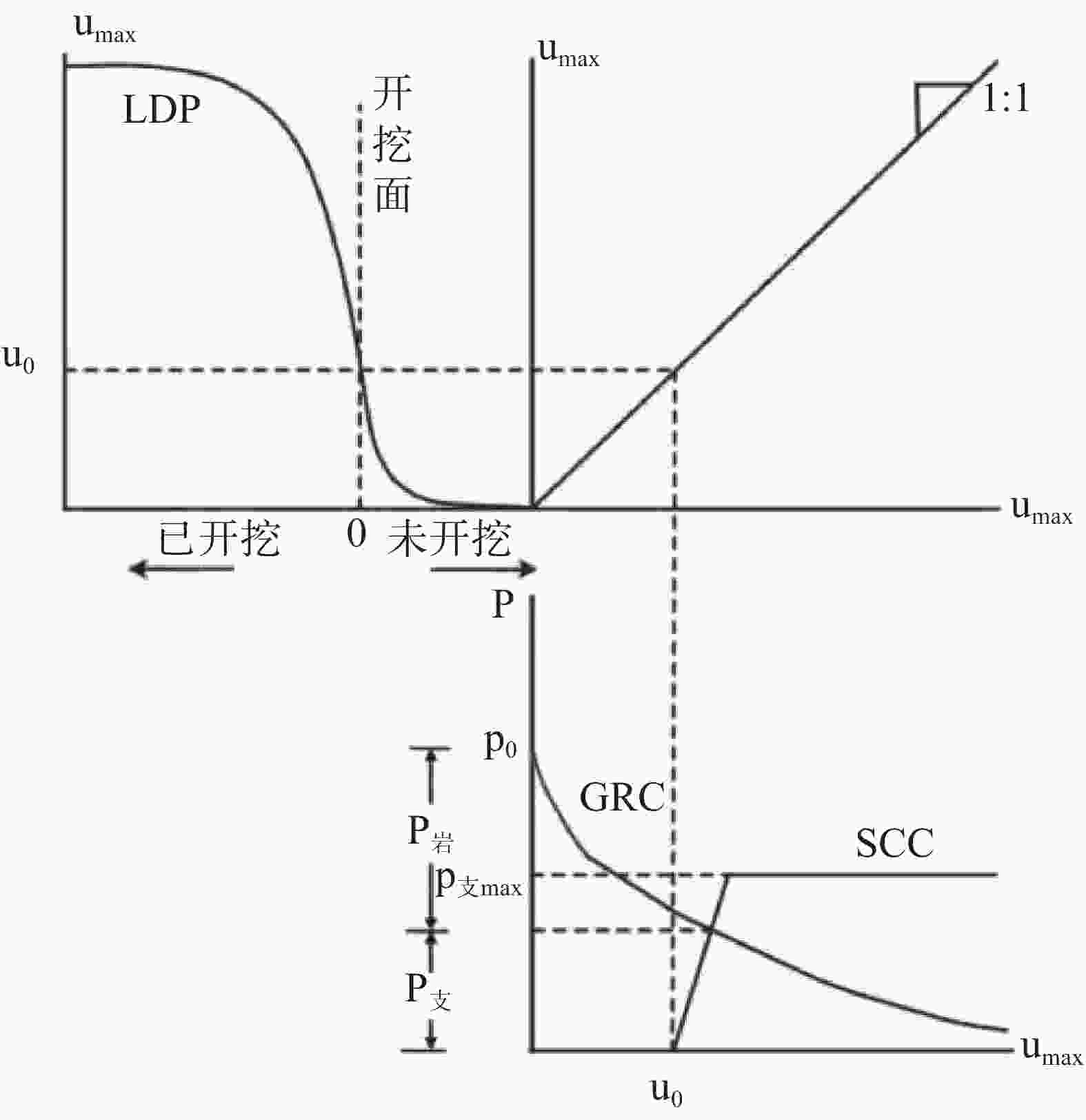
 下载:
下载:
